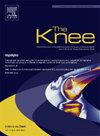Location of the popliteal artery during medial and lateral distal femoral osteotomy: A retrospective study using contrast-enhanced computed tomography-based three-dimensional models
IF 2
4区 医学
Q3 ORTHOPEDICS
引用次数: 0
Abstract
Background
Intraoperative popliteal artery injury during distal femoral osteotomy (DFO) is a fatal complication that requires detailed anatomical examination. We evaluated the location of the popliteal artery in medial and lateral DFO using contrast-enhanced computed tomography (CT)-based three-dimensional (3D) models.
Methods
This retrospective observational study included 30 knees that underwent contrast-enhanced CT primarily for cardiovascular disease. Osteotomy planes for medial and lateral DFO were created using 3D models. The popliteal artery distance was measured as the distance between two points where the bone and blood vessels were closest to each other, the location of the popliteal artery was determined by dividing the distance from the starting point to the nearest arterial point by the total osteotomy distance, and the angle closest to popliteal artery was defined as the angle formed by three points: the osteotomy starting point and the points near the bone and popliteal artery, in both models.
Results
The shortest distance from the artery to the osteotomy line did not differ significantly between the lateral DFO (13.5 ± 3.0 mm) and medial DFO groups (14.2 ± 3.5 mm). The ratio of popliteal artery location was significantly closer to the osteotomy starting point in the lateral DFO group (0.29 ± 0.12) than in the medial DFO group (0.45 ± 0.13) (P < 0.001). The angle closest to the artery was significantly larger in the lateral DFO group (31.1 ± 6.9°) than in the medial DFO group (26.9 ± 7.7°) (P < 0.05).
Conclusion
In distal femoral osteotomies, the popliteal artery requires more attention during medial DFO than during lateral DFO.
股骨远端内侧和外侧截骨术中腘动脉的位置:一项基于三维模型的对比增强计算机断层扫描的回顾性研究
背景:股骨远端截骨术(DFO)中腘动脉损伤是一种致命的并发症,需要详细的解剖检查。我们使用基于对比增强计算机断层扫描(CT)的三维(3D)模型评估腘动脉在DFO内侧和外侧的位置。方法本回顾性观察性研究包括30例膝关节,主要因心血管疾病接受了CT增强扫描。使用3D模型创建内侧和外侧DFO的截骨平面。腘动脉的距离测量两点之间的距离,骨骼和血管互相接近,腘动脉的位置是由分隔的距离最近的动脉起点点的总距离截骨术,和角接近腘动脉被定义为三个点形成的角度:截骨术的起点和骨头和腘动脉附近的点,在这两个模型。结果桡动脉到截骨线的最短距离在DFO外侧组(13.5±3.0 mm)和DFO内侧组(14.2±3.5 mm)之间无显著差异。DFO外侧组腘动脉位置与截骨起点的比值(0.29±0.12)明显接近于DFO内侧组(0.45±0.13)(P <;0.001)。DFO外侧组最靠近动脉的角度(31.1±6.9°)明显大于DFO内侧组(26.9±7.7°)(P <;0.05)。结论股骨远端截骨术中,内侧去骨比外侧去骨更需要注意腘动脉。
本文章由计算机程序翻译,如有差异,请以英文原文为准。
求助全文
约1分钟内获得全文
求助全文
来源期刊

Knee
医学-外科
CiteScore
3.80
自引率
5.30%
发文量
171
审稿时长
6 months
期刊介绍:
The Knee is an international journal publishing studies on the clinical treatment and fundamental biomechanical characteristics of this joint. The aim of the journal is to provide a vehicle relevant to surgeons, biomedical engineers, imaging specialists, materials scientists, rehabilitation personnel and all those with an interest in the knee.
The topics covered include, but are not limited to:
• Anatomy, physiology, morphology and biochemistry;
• Biomechanical studies;
• Advances in the development of prosthetic, orthotic and augmentation devices;
• Imaging and diagnostic techniques;
• Pathology;
• Trauma;
• Surgery;
• Rehabilitation.
 求助内容:
求助内容: 应助结果提醒方式:
应助结果提醒方式:


